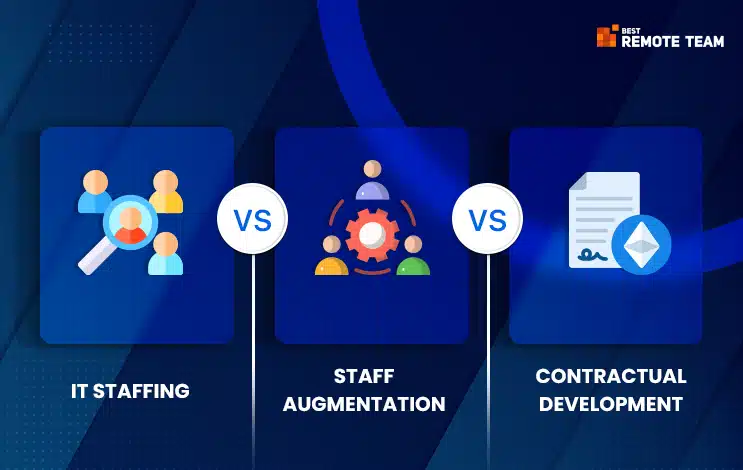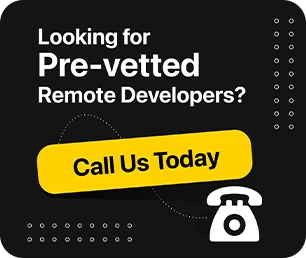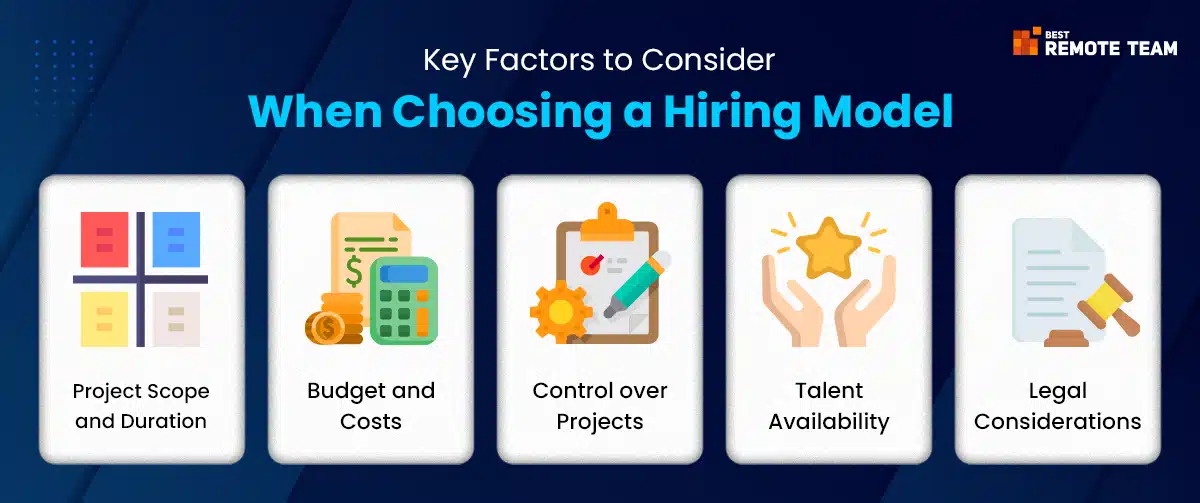What is IT Staffing Model?
If you are planning to fill permanent positions in your IT department with the right expertise, you should go with the IT staffing model. With this approach, you can identify the skills and knowledge your business needs for a longer term.
If your expertise is in web development, you need people well-versed in Java and .Net technologies. As a reputed development company, you need to hire programmers on your payroll permanently, so that you can roll out the solutions seamlessly.
As IT staffing works on a more permanent hire, you will notice that the resources are aligned with your culture and operations. As a result, they understand your requirements better and can offer relevant solutions. It also fosters creativity, which enables innovative solutions for your business.
You will also receive consistent support and maintenance from the team, as they are dedicated to your business and project. This model can impact your bottom line in the most positive way.
5 Key Benefits of the IT Staffing Model
- When you have a permanent employee onboard, you get the continuity and stability your project needs. As they are familiar with the culture and systems, it improves the overall trust.
- As they are permanent staff members, they integrate with your company’s values and work environment. This makes it easier for you to operate.
- They have specific domain knowledge, which helps in furthering the business and innovating the solutions.
- With the dedicated teams, you are likely to experience a lower churn rate. This would also lower the cost of training and onboarding the members.
- Internal teams grow with your business and evolve to meet newer needs. As a result, they are core to consistent development and long-term planning.
Challenges of IT Staffing Model
- When you are hiring an internal team, you need to pay for the recruitment and training of the employees. This can increase the overall cost of hiring and managing the staff.
- When you need resources for a short period, you can use this approach. It can help you identify the relevant resources.
- It is a time-consuming approach, as you need to spend a lot of time and effort into hiring the right people.
- It can help you overcome the skill gaps that exist in your current team temporarily.
- In case people decide to resign from their positions, it can turn into a churn for the business. This can impact the hiring and recruitment costs and also disrupt your operations.
People also read: IT Staff Augmentation vs IT Project Outsourcing
What is Staff Augmentation Model?
Imagine hiring a resource for a project where you need extra hands. It could also be for a project where you need specific skills that are unavailable in-house.
Using this model, you can close the gap that exists in a software development team and ensure a seamless flow of work. As you are hiring them temporarily, you need not worry about adding permanent overheads to the company.
Moreover, this approach allows you to access a broad talent pool and relevant expertise to suit your project needs. You can easily meet your growing resource requirements for streamlined operations at any time.
Whether you need to manage the sudden increase in workload or finish a project on time, you can use this approach. For example, during the holiday season, you may experience a shortfall of people in the team. Staff augmentation can help manage the continuity, by offering you the resources.
5 Key Benefits Staff Augmentation Model
- You can easily scale your workforce up or down, based on your individual needs and commitments without adding any overhead.
- Access specialized skills by bringing in experts and people with specific knowledge to fill the skill gaps.
- It can reduce the cost of hiring, training or even maintaining permanent hires.
- You can onboard bigger teams and integrate them with your business faster, which is useful when you need to meet tight deadlines.
- It eliminates the risk of adding permanent hires to the business, which can reduce the burden of layoffs and excessive payroll expenses.
Challenges of Staff Augmentation Model
- When you are hiring temporary resources, they may not align with the company’s culture or long-term goals.
- In this approach, the person responsible for the project will leave at the end of it. They will also take away their expertise in the long run.
- You have to continuously oversee their work and coordinate with the permanent team members.
- There is a lot of dependency on external talent, which can weaken your internal team.
- Businesses generally use this approach when they have a short-term focus on their goals and milestones.
What is Contractual Development Model?
In this approach, you outsource the entire project to a third-party vendor or agency. When you need specific expertise or need to focus on your jobs while managing your IT needs, you can choose this approach.
It maximizes your productivity while letting you concentrate on things you know best. The team will handle the jobs that need an expert’s hand without burdening you with management or continuous monitoring of the resources.
The company or agency you have outsourced to would have a pre-assembled team that can function fast on your requirements and streamline the operations. You save hiring costs, get a lot of flexibility and ensure faster time-to-market with this method. It makes up for the scalability and efficiency needs as well.
5 Key Benefits of Contractual Development Model
- The external vendor has complete ownership of the project, which means there is minimal to no workload on your resources.
- You get to work with a pre-assembled team that is tailored to meet your unique project requirements.
- You save a lot of money on hiring, training and even maintaining the resources needed for the project.
- You get to launch the product faster into the market, thus ensuring an edge over competition.
- You can easily scale the resources to meet the newer needs or goals of the project.
Top Challenges of Contractual Development Model
- Some organizations experience a loss of control as they are not equipped with complete insight into the day-to-day operations of the project.
- There are communication gaps that can cause misunderstandings or delays in the project.
- The biggest challenge is ensuring that the outsourcing team meets your quality and standard guidelines while creating the product.
- You are reliant on an external vendor for your entire project, which can hamper your business outcomes and progress.
Top 5 Factors to Consider When Choosing an IT Resource Model
When choosing a model for hiring your team, you should consider certain important factors. Here are the top factors that we believe influence your choice.
#1 Project Scope and Duration
Your scope and project duration have a significant impact on the workforce model you plan to choose for the upcoming project. In case of long-term projects, you need consistent attention. That’s where you should options for the IT staffing approach. It helps build a stable and reliable team.
In case you need specific skills or must hire someone temporarily, you can use the staff augmentation model. The contractual development model works best for short-term projects or projects with a specific timeline. In this case, you can depend on external vendors to help you achieve your project goals and timeline.
So, before you set out to choose the model that works best, start defining the scope and duration of the project.
#2 Budget and Costs
When you are choosing an approach, you need to consider how it can impact your overheads before proceeding. For instance, the staffing model will require you to spend a lot of money on hiring, recruitment and other related costs. However, a contractual model is a fixed-price model and can prove to be cost-effective.
Consider how much time and effort you are likely to spend on training, maintaining and recruiting the resources for each model. Look how permanent the hires would be, and conduct a cost-benefit analysis.
if you are working on a limited scope and short project, contractual development will be beneficial to you. however, if you plan to conduct a long-term project, having resources in-house would serve the purpose.
#3 Control Over Projects
How much control would you like on your projects? The answer to this question would help you find the ideal workforce model for software development. If you want limited control of the project, you can use the contractual development model. however, if you want maximum control over the operations, you should go with IT staffing.
Staff augmentation also offers control over the projects, as you tend to hire external resources who can work alongside the in-house resources. Depending on how often you want to control the project or monitor its progress, you can choose the workforce model.
#4 Talent Availability
When you are selecting the right talent, you should invest in a good workforce model. IT staffing can take a lot of time and effort to find the right person to recruit. That’s why it is considerably slower in case you need an immediate talent for the purpose.
Staff augmentation can offer a broader talent pool and is ideal when you need skilled resources for a short period. In case you need a pre-assembled team from the start filled with experts, you might want to opt for the contractual development model.
When you need talent and for how long you need them will help decide the ideal model.
#5 Legal Considerations
Legal factors including the employment laws and regulations applicable for each of the workforce models are crucial in selecting the right one. You must look at the termination policies, employee benefits and classifications before making the choice.
Again, tax implications are also important in choosing the right approach. You should do a detailed analysis of liability vs risk before you choose a model that fits your needs. lastly, compliance with the labor standards is equally important in making the selection.
When to Choose What?
Here are all the scenarios when you can choose a particular model. Let’s look at which scenario is best for the particular workforce model.
When to Choose IT Staffing Model?
This model is best suited when you need in-house experts who can offer long-term and continuous operations. You must choose this model when your team needs more permanent members on the board. It is best fit for long-term commitment needs.
Additionally, it is suited for projects that need consistency, cultural alignment and in-depth knowledge. These resources can offer the stability and commitment you need to grow your business and achieve your long-term goals.
When to Choose Staff Augmentation Model?
In case you wish to fill temporary skill gaps or require resources for a specific project requirement, you can use this model. It can help you meet the seasonal demands or temporary increase in workload efficiently.
Moreover, you can also hire people without long-term commitment using this model. It is also fit for projects where timelines are very specific and flexibility is the core requirement.
When to Choose Contractual Development Model?
Outsourcing an entire project is best suited when you need to deliver specific projects within the defined timeline. It is a good investment if you have a limited in-house team and the extra project can burn into your productive hours. This will allow you to focus on the core business functions, while someone else takes care of the actual project development.
What are the Hybrid Approaches?
A hybrid approach is an effective combination of the three workforce models we discussed in this article. It combines IT staffing with staff augmentation and contractual development to optimize the execution and team scalability. By combining these models, you can achieve flexibility and control to access specific skills.
Benefits of a Hybrid Approach
- Businesses can scale their workforce flexibly with the hybrid model by combining the stability of permanent employees with the agility of temporary hires.
- You can manage the long-term costs by hiring a dedicated team for stability while hiring external skilled resources to manage specific tasks.
- You can access expertise while having an in-house team to manage the entire project and continuously monitor it.
- Combining internal and external teams can help you innovate the solution and improve problem-solving.
Challenges of a Hybrid Approach
- When you are managing multiple teams, internal and temporary, you may face operational and communication challenges.
- There is a possibility of cultural misalignment with the augmented and outsourced teams. As they don’t align with the company’s culture or long-term goals, you may need to put in extra effort.
- You might face risks related to security breaches when sharing sensitive information with external partners.
Successful Examples of the Hybrid Approach
- Tech startups have used a hybrid approach to combine their core team of developers with a dedicated team of UI/UX design or backend development to speed up product deployment. Startups can scale their products easily and manage agility while focusing on innovation.
- Companies like Google have also employed the hybrid workforce model to manage their core operations and enhance productivity. Their core team works on the nitty-gritty of the project while the specialized team can implement the additions to the product.
Final Thoughts!
It is crucial for you to choose the right workforce model, whether it is IT staffing or contractual development. You can also use the hybrid approach to align your vision with the business goals.
Each workforce approach has its specific pros and cons. For instance, IT staffing allows you to enjoy long-term stability while contractual development improves talent availability and flexibility.
You should consider the project scope, budget and talent availability before choosing the right workforce model. Hybrid approach can offer a balanced solution, enhancing productivity and agility of the business.
When selecting the model, you should view the project’s success and operational efficiency.
Looking for a dedicated team to handle your IT needs remotely? Contact us today and get customized solutions tailored to your business needs.






